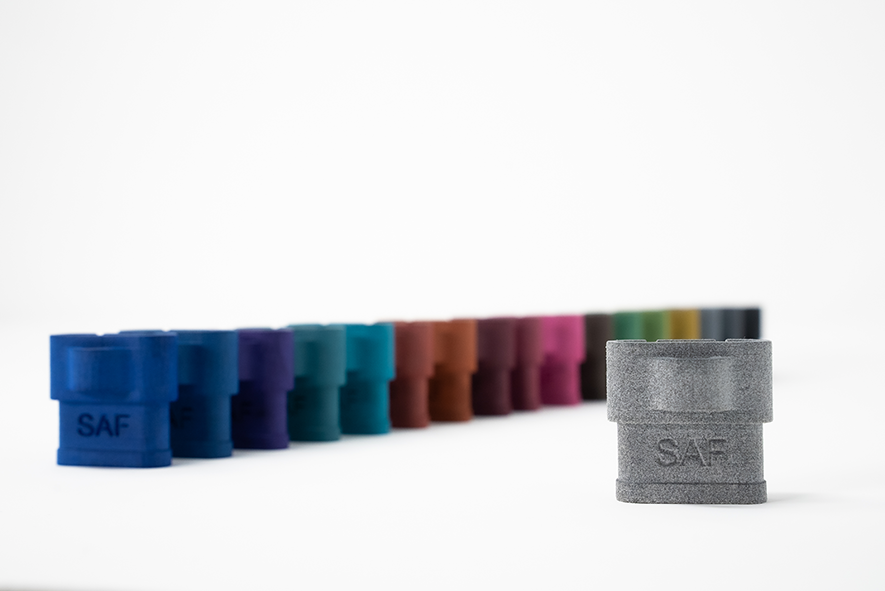Nano Dimension (Nasdaq: NNDM) has been on an acquisition spree over the past year, picking up smaller businesses that can strengthen its portfolio. Its most recent buy, however, isn’t so small. The U.S.-Israeli electronics 3D printing firm has purchased 12.12% of the outstanding ordinary shares of 3D printing stalwart Stratasys Ltd. (Nasdaq: SSYS).
With its DragonFly IV 3D printer, Nano Dimension enables customers the ability to produce printed circuit boards (PCBs) with complex geometries. This has given it the ability to acquire several firms that will make up an increasingly advanced additively manufactured electronics (AME) platform.
 Nano Dimensions’ electronics 3D printing process. Image courtesy of Nano Dimension.
Nano Dimensions’ electronics 3D printing process. Image courtesy of Nano Dimension.The purchase of Nanofabrica brings micro additive manufacturing (AM) capabilities to the company, while its acquisition of Deep Cube powers machine learning for improved quality control. Buying Essemtec adds electronics assembly. Most recently, Nano Dimension grabbed Admatec and Formtec, the exact implications of which for AME is still unknown. However, it’s possible that these open up the ability to 3D print metal and ceramic parts for PCBs. Moreover, they provide additional revenue streams for Nano Dimension.
Now, Nano Dimension has taken out a chunk of Stratasys shares, which could give it a say in the firm’s business decisions, allow the two companies to grow one another mutually, and give it more funds going forward. This is particularly important since, as one of the most established original equipment manufacturers (OEM) in the 3D printing space, Stratasys has the largest market share of any AM OEM.
 Stratasys sintered parts processed with DyeMansion coloring technology. Image courtesy of Stratasys.
Stratasys sintered parts processed with DyeMansion coloring technology. Image courtesy of Stratasys.Stratasys’s market share, however, has also been declining year over year, according to the latest Wohlers Report. It has swapped out CEOs regularly since the consumer 3D printing bubble of 2014. In Q1 of 2021, it did have its strongest quarter in six years, and generated $521 million in revenue in 2020 and $607 million in 2021. Stratasys has made its own purchases, including that of Xaar 3D to power its new polymer sintering technology, as well as Origin and RPS to give it vat photopolymerization technologies. Interestingly, Stratasys also sold MakerBot to Ultimaker, while also investing in the latter company. Altogether, it has one of the widest technology portfolios after 3D Systems, including its material extrusion process and inkjet. Inkjet, in particular, should complement the inkjet process of Nano Dimension’s own Dragon Fly IV system, which 3DPrint.com saw in person earlier this year.
Yoav Stern, Chairman and Chief Executive Officer of Nano Dimension, commented: “The purpose of Nano Dimension in buying Stratasys shares is the formation of a strategic investment in a market-leader which is well established in a relatively seasoned market segment, while Nano Dimension’s disruptive technologies in AME and 3D metal printing supply its shareholders with value created by accelerated growth and expansion curves. Hence, an investor in Nano Dimension will gain from its value creation in ‘blue ocean’ type AM sectors plus having strategic upside from investment in Stratasys, which enjoys a commanding presence in large, stable more mature, mostly polymer-based AM technologies. In contrast, Nano Dimension’s material development thrusts and business model strategy are centered around metals with electro-mechanical conductive parameters, metals with superior mechanical qualities, dielectric material, and printing of multi-dimensional-electronic devices and mechanical parts.
“Incidentally,” Mr. Stern concluded, “We may increase or decrease our investment in Stratasys, subject to market conditions and other economic factors, while keeping it under the framework and envelop which will evolve from the description above.”
Given that, through its 2012 merger with Objet, Stratasys is also partially Israeli, the synergies with Nano Dimension are strong. If the two were to form a single entity, it would create the only major OEM capable of electronics 3D printing. Though this is still an emerging sector, it’s obvious that companies ranging from Google to Apple, as well as every major military, is researching electronics 3D printing. So, the prospect of a complete merger would be an enticing one. 3DPrint.com’s Matt Kremenetsky suggested that a major 3D printer OEM purchase an AME firm and it’s possible that that could play out, though not exactly as envisioned.
Subscribe to Our Email Newsletter
Stay up-to-date on all the latest news from the 3D printing industry and receive information and offers from third party vendors.
Print Services
Upload your 3D Models and get them printed quickly and efficiently.
You May Also Like
Consolidation in AM: How 2025 Is Shaping the Industry’s New Normal
The first half of 2025 has been marked by a clear shift in the additive manufacturing (AM) industry. Companies are no longer just focused on developing new tech by themselves....
Etsy Design Rule Change Reduces Selection of 3D Printed Goods
Online marketplace Etsy has implemented a rule change requiring all 3D printed goods on the site to be original designs. The update to the site’s Creativity Standards states, ¨Items produced using...
U.S. Congress Calls Out 3D Printing in Proposal for Commercial Reserve Manufacturing Network
Last week, the U.S. House of Representatives’ Appropriations Committee moved the FY 2026 defense bill forward to the House floor. Included in the legislation is a $131 million proposal for...
Transforming From Tourist to Native: Duro CEO Michael Corr Explains Why the Company Rebuilt its PLM Software on AI
In these early innings of the AI boom, many market analysts have expressed concern that AI spend has gotten too far ahead of the technology’s proven ability to deliver significant...
































